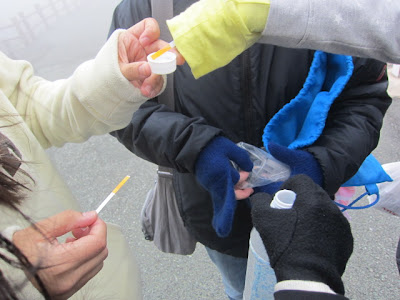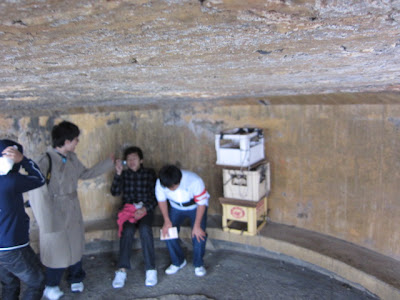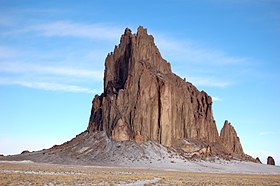PROUD TO PRESENT...
JTEAM FIRST EVER VIDEO OF MOUNT ASO!
Saturday, December 4, 2010
Friday, November 19, 2010
Now we are back in SINAPORE!
Yeah! We are back now in singapore!
Trip to Japan was really great and fun! Indeed we learned lots of things from there :)
These are some questions asked by our readers!
Trip to Japan was really great and fun! Indeed we learned lots of things from there :)
These are some questions asked by our readers!
1.Would you recommend that Singapore build a nuclear plant? If so, how could we protect ourselves from its adverse effects?
We would recommend Singapore to build one as we feel that by doing this, we can help to save the environment as it has lesser pollution compared to the other methods. It is a much more lengthy solution to the current burning of coal, gas and oil. The effects of the pollution are accumulative. The cause and effect are not often easy to trace. The illness may appear years after initial exposure. However, we can consciously minimize some areas or pollution by a considered change in lifestyle. For example, by eating organic food, especially anti-oxidant food and nutrients which mop up pollutants in the body. Eating plenty of fruits and vegetables also gives you vitamins A and C. We can also minimize by taking care to use only eco-friendly products like vinegar. The use of cosmetics can be reduced and only natural creams and skins cleansers applied. Those of us sensitive to television screens can try to reduce the amount of time spent in front of them, this applies particularly to young children. Lastly, we can try to manage life without a car or experiment with car sharing schemes. All the above mentioned actions help to protect us from its adverse effects.
2.What do you suggest Singapore can do to protect itself against possible dangers if a big earthquake were to strike us.
Singapore should educate the public about the seriousness of earthquake and also to tell them what to do when a big earthquake were to strike us. This can be done through schools, community centers and many other places. We can protect ourselves by standing under a doorframe of crouching under a table or chair until the shaking stops. We should not go outdoors until the shaking has stopped completely. Even then, we should use extreme caution. A large earthquake may sometimes be followed by smaller ones, called aftershocks. We should stay clear of walls, windows, and damaged structured, which could crash in an aftershock.
3.Beside tourists, how is the Fukuoka City Disaster Prevention Center useful for the Japanese as a whole ?
By spreading the knowledge they know about earthquakes and how dangerous they can be to the people in Japan will definitely help them when such things were to happen. For example, the center provide simulations to allow the people to experience how does it feels like to be in an actualy situation. This also gives them the opportunity to practice the actions that need to be done to ensure their own safety during an earthquake.
4.What does the result of pH 3-4 tell you about the air?
Acid range from pH 1 to 7. While Alkaline range from pH 8 to 14. Hence, pH 3-4 tell us that the air (sulphur dioxide at Mount Aso) is quite acidic.
5.Did you observe any iron structures up in the mountains? Were they rusty? Why?
If you can spot some iron there.. THEY ARE RUSTY.
The reaon why is because at the Volcano, sulphur dioxide gas are all around. Hence, sulphur dioxide made the iron rust easily.
Monday, November 15, 2010
We visited Mount Aso!
Today.. WE VISITED MOUNT ASO!! ^^
( Thanks Regina for being a hand model here :P )
When we reached the mountain, Mdm Tan gave us pH paper to test the PH value of thes ulfur dioxide in the air there!
And the result seem to be around 3.4! :)
We started to walk further in towards Mount Aso but its very very cold up there!
And we saw this 'hut' made of stone! Then we found out that its a place to hide in case Mount Aso suddenly erupt!
After that, we really couldnt take it anymore and went back! :)
Luckily..there is a heater there ^^
Although we didn see the blue boiling water in Mount Aso, we still went to the museum to learn more about it!!
Its late now~!
We will answer the questions soon! :)
Goodnights!
( Thanks Regina for being a hand model here :P )
When we reached the mountain, Mdm Tan gave us pH paper to test the PH value of thes ulfur dioxide in the air there!
And the result seem to be around 3.4! :)
We started to walk further in towards Mount Aso but its very very cold up there!
And we saw this 'hut' made of stone! Then we found out that its a place to hide in case Mount Aso suddenly erupt!
After that, we really couldnt take it anymore and went back! :)
Luckily..there is a heater there ^^
Although we didn see the blue boiling water in Mount Aso, we still went to the museum to learn more about it!!
Its late now~!
We will answer the questions soon! :)
Goodnights!
Saturday, November 13, 2010
We are in JAPAN NOW!
Today is our DAY 1 in JAPAN! :)
Here's are some pictures of OUR TEACHERS EXPERIENCING IT--> EARTH QUAKE!
And TADA! Its fun!^^
Of course, we tried the strong wind experience too :)
Next Stop! ROBO SQUARE!
Yup! We saw many cool and high tech Robots! ^^
NEXT! We took a VERY long bus ride to... Nagasaki Atomic Bomb Museum!
This museum commemorates the explosion of the atomic bomb that devastated Nagasaki at 11.02am on 9august.
We then also visited Peace park!
The park is built to commemorate the victims of the woeful event in 1945!
This statue's right hand pointing upward depicts the threat of the atomic bomb, the left hand stretching horizontally symbolizes eternal world peace, and the closed eyelids express the consolation for the war dead!
SO... Some questions to answer..
How does radiation from the atomic bomb affect the genes of the victims?
The radiation effects has affected the bodies of their parents. Therefore, the following generations have no choice but to inherit the affected genes from their parents. Thus, they were born malformed.
Do you think dropping the atomic bombs was necessary? What other alternatives could America have adopted?
No, i dont think that dropping the atomic bombs was necessary. As this will only result in killing more innocent lives. The Amercia could have solve this problem by discussing and having a peace talk with Japan instead of using bombs to out stand their presence.
IN ALL,
J Team had fun today! Although its only the first day and had a long bus ride, we still had fun discovering new things and learned more interesting things :) We are looking forward to the next day! :)
Of course, we had lots of fun!
Firstly, We went to Fukuoka City Disaster Prevention Center!
This centre was established in January 19, 1992, where students will acquire knowledge, techniques on disaster prevention!
As you know, Singapore do not experience Earthquake and Strong wind. Hence, today, J TEAM TRIED EXPERIENCING THEM! ^^
Here's are some pictures of OUR TEACHERS EXPERIENCING IT--> EARTH QUAKE!
And TADA! Its fun!^^
Of course, we tried the strong wind experience too :)
Next Stop! ROBO SQUARE!
Yup! We saw many cool and high tech Robots! ^^
NEXT! We took a VERY long bus ride to... Nagasaki Atomic Bomb Museum!
This museum commemorates the explosion of the atomic bomb that devastated Nagasaki at 11.02am on 9august.
We then also visited Peace park!
The park is built to commemorate the victims of the woeful event in 1945!
This statue's right hand pointing upward depicts the threat of the atomic bomb, the left hand stretching horizontally symbolizes eternal world peace, and the closed eyelids express the consolation for the war dead!
SO... Some questions to answer..
How does radiation from the atomic bomb affect the genes of the victims?
The radiation effects has affected the bodies of their parents. Therefore, the following generations have no choice but to inherit the affected genes from their parents. Thus, they were born malformed.
Do you think dropping the atomic bombs was necessary? What other alternatives could America have adopted?
No, i dont think that dropping the atomic bombs was necessary. As this will only result in killing more innocent lives. The Amercia could have solve this problem by discussing and having a peace talk with Japan instead of using bombs to out stand their presence.
IN ALL,
J Team had fun today! Although its only the first day and had a long bus ride, we still had fun discovering new things and learned more interesting things :) We are looking forward to the next day! :)
Saturday, November 6, 2010
Mount Everest is not a volcano.
Some people asked about Mount Everest.
Mount Everest was formed about 60 million years ago . It is one of the world's highest Mountain!
However, it is not a volcano :)
Wednesday, November 3, 2010
Some of the extinct and active volcanoes.
Firstly, lets define the Active, Erupting, Dormant and Extinct volcanoes!
Its the volcanoe that we will be visiting!
- An active volcano is a volcano that has had at least one eruption during the past 10,000 years. An active volcano might be erupting or dormant.
- An erupting volcano is an active volcano that is having an eruption.
- A dormant volcano is an active volcano that is not erupting, but supposed to erupt again.
- An extinct volcano has not had an eruption for at least 10,000 years and is not expected to erupt again in a comparable time scale of the future.
So..What are some of the extinct volcanoes?
Located in the Hegau region of Baden-Württemberg in southern Germany.
It is a cinder cone volcano in the Mexican state of Michoacán.
Located above the high-desert plain on the Navajo Nation and in San Juan County, New Mexico
And some of the active volcanoes!
Located at Itlay!
Located at Indonesia !
Hope you had learned something from here! :)
Thursday, October 28, 2010
V.O.L.C.A.N.O.E.S
Volcanoes are an opening or rupture in a planet's surface which allow hot magma, ash and gases to escape from below the surface!
Besides forming volcanoes by convergenting tectonic plates coming together, some volcanes are formed where there is stretching and thinning of Earth's crust!
Effects of Volcanoes
1) Volcanoes carries red hot lava which will destroy and burn everything that comes in its way
2) Volcanic eruptions contain alot of harmful gases (carbon dioxide, sulfur dioxide, water vapor, hydrogen sulfide, hydrogen fluoride, hydrogen chloride, carbon monoxide, halocarbon and metal chlorides) that can create a lot of changes in the Earth's atmosphere.
3) Causes landslides and Lahar/Mud flow . Lahar often contains rocks, mud and water which will also destroy things on their way rolling down the distance with great speed!
4) Volcanic ash. It consists of small and sharp rock particles formed from the break down of magma. Explosive eruptions of volcanoes will then throw these particles to long distance.
Besides forming volcanoes by convergenting tectonic plates coming together, some volcanes are formed where there is stretching and thinning of Earth's crust!
Effects of Volcanoes
1) Volcanoes carries red hot lava which will destroy and burn everything that comes in its way
2) Volcanic eruptions contain alot of harmful gases (carbon dioxide, sulfur dioxide, water vapor, hydrogen sulfide, hydrogen fluoride, hydrogen chloride, carbon monoxide, halocarbon and metal chlorides) that can create a lot of changes in the Earth's atmosphere.
3) Causes landslides and Lahar/Mud flow . Lahar often contains rocks, mud and water which will also destroy things on their way rolling down the distance with great speed!
4) Volcanic ash. It consists of small and sharp rock particles formed from the break down of magma. Explosive eruptions of volcanoes will then throw these particles to long distance.
Subscribe to:
Comments (Atom)









































